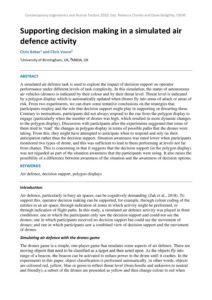| Document | Author Chris Baber and Chris Vance |
| Abstract A simulated air defence task is used to explore the impact of decision support on operator performance under different levels of task complexity. In this simulation, the status of autonomous air vehicles (drones) is indicated by their colour and by their threat level. Threat level is indicated by a polygon display which is automatically updated when drones fly into areas of attack or areas of risk. From two experiments, we can draw some tentative conclusions on the strategies that participants employ and the role that decision support might play in supporting or thwarting these. Contrary to instructions, participants did not always respond to the cue from the polygon display to engage (particularly when the number of drones was high, which resulted in more dynamic changes to the polygon display). Discussion with participants after the experiments suggested that some of them tried to ‘read’ the changes in polygon display in terms of possible paths that the drones were taking. From this, they might have attempted to anticipate when to respond and rely on their anticipation rather than the decision support. Situation awareness was rated lower when participants monitored two types of drone, and this was sufficient to lead to them performing at levels not far from chance. This is concerning in that it suggests that the decision support (in the polygon display) was not regarded as part of the situation awareness that the participants were using. It also raises the possibility of a difference between awareness of the situation and the awareness of decision options. |

